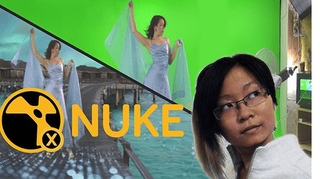Nuke Compositing 101: Introduction and Best Practices!
Compositing is the process of combining elements from several different sources to create a coherent image. Even though the scene might be a combination of fragments, professional compositing techniques are highly convincing. In this Nuke compositing course, we will be taking a look at the basics and best practices of Nuke. The latter software application is for node-based digital compositing and visual effects.
If you have never heard of Nuke compositing (or compositing in general), I am sure you have seen it in films, commercials, or other video content. Sometimes the applied visual effects are very subtle. For instance, digital compositors might add a water bottle in one scene without you noticing that it wasn’t really there during filming. After learning how to use Nuke, you will be able to add similar or much more full-fledged effects to your content.
Compositing: definition and application
Polished compositing is art, no doubt about it. In this course on Nuke compositing, I will begin by providing you with a clear definition. Therefore, you will quickly be able to recognize that compositing is a process of combining multiple visual elements into one. A very basic example of compositing would be adding rabbit ears to your selfie or a pair of sunglasses.
However, such examples might be associated with primitive combinations of different elements. In this Nuke tutorial, you will be able to learn how to make the added components look as if they belong there. The better you are at Nuke, the more realistic scenes you will be able to produce.
Therefore, learning how to use Nuke involves many hours you spend practicing techniques. In this course on Nuke compositing, I will introduce you to various tips and tricks to help achieve your goals in a more timely manner. Additionally, these recommendations will give you the foundation that you need to start your own original projects as well.
What will you find in this course?
In this Nuke tutorial, we look at the concept of compositing and the way it can be achieved in the Nuke software application. This tool is used in the majority of visual effects studios, and now, you have a chance to learn it as well.
My course is very beginner-friendly. If you have never heard of compositing or Nuke, you are welcome to join me! If you have used other programs for visual effects such as Adobe After Effects, I will help you make the transition to compositing in Nuke by reviewing the differences in their interfaces and the functionality overall.
To learn compositing in Nuke, you need to start working on projects and examples to feel the actual impact that you can make. Therefore, I will offer you a chance to follow my lead when using the tools of Nuke for playing around with content. Opportunities are endless after you become a skilled Nuke compositing specialist! Additionally, like the cherry on top, I offer some bonus lectures for you to enjoy!
